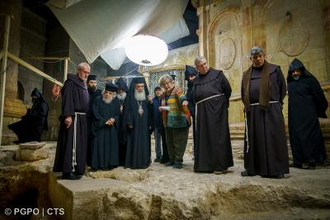Holy Sepulchre: Statement on the work in progress

Holy Sepulchre excavations, Credit: Holy Land Christian Ecumenical Foundation
Source: Holy land Christian Ecumenical Foundation
On 11 January 2023, on the occasion of the visit of the leaders of the Communities to the archaeological site in Holy Sepulchre complex in Jerusalem, we presented the excavations in progress. Archaeological investigations are conducted by the Department of Antiquities of the University of Rome Sapienza.
Archaeological investigations are connected with the restoration project of the floor of the religious complex and follow it in different and progressive areas, to allow the religious performance of the liturgies by the various confessions and the visit to the complex by pilgrims. Excavations began in May 2022 and were focused part of the north nave, the northern half of the Rotunda and the intermediate zone.
The work is currently concentrated on the southern part of the Rotunda. The work is carried out in a continuous cycle, day and night. The archaeologists that are working in Jerusalem are supported by the rest of the team in Rome, where all the data are processing in real time.
In the southern part of the Rotunda the quarry, as in the other areas, degrades from north-west to south-east, with very different heights; its depth in this area goes from a few cm to over 2m. The traces of the wedges and the cuts to detach the stones, often very large, are clearly visible. Directly on the quarry are based the foundations and substructures of the Roman age. These can be attributed to the works promoted by the Emperor Hadrian (117-138): in this area written sources recall a temple.
Most of the Roman buildings were discovered in 1974. Now this area has been investigated again, removing the old cover, for new documentation and a correct connection with the new archaeological data.
The heavy destruction of the Roman buildings is also due to the lowering of the whole area of the Rotunda in the first decades of 4th century, to discover and monumentalise the venerated tomb, identified as the tomb of Christ. Most of the Roman structure was destroyed, and the rock was cut to the base of the tomb, excavated in the hill, to create a flat area. The remains of the early monumentalisation of the tomb were found under the present nineteenth-century aedicule. It is a circular floor in reused marble, carefully worked, whose circumference includes the whole area of the tomb. Even the most ancient representations of the tomb show a circular monument.
The remains of two floors, both in opus sectile, were also found. The oldest uses slabs of white and grey marble. This floor is placed directly on the rock or, if the level is lower, on layers of earth. A second, higher floor, is of reused marble, with porphyry and abundant cipolin. Sporadic fragments of it were also found in the northern area of the Rotunda.
The complexity of stratigraphy requires that we continue the archaeological investigations and the study of the artefacts, to determine sequences and chronologies and to propose philologically correct reconstructions.
Link: https://hcef.org/


















